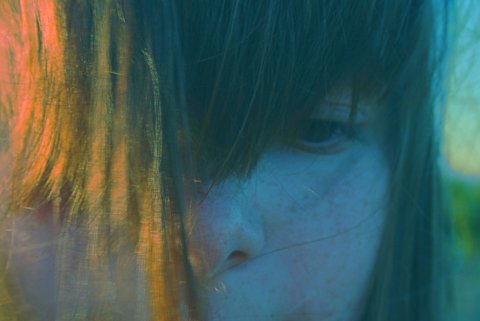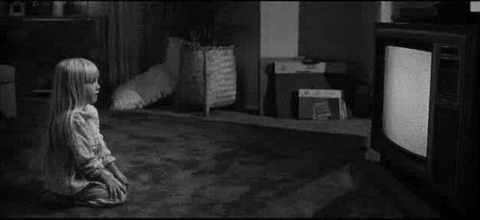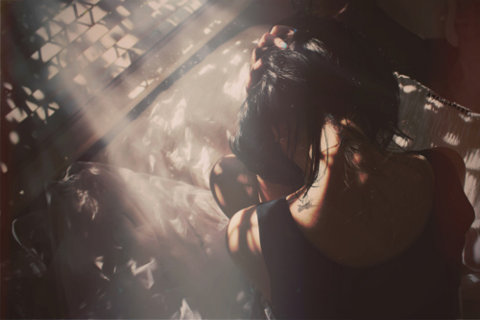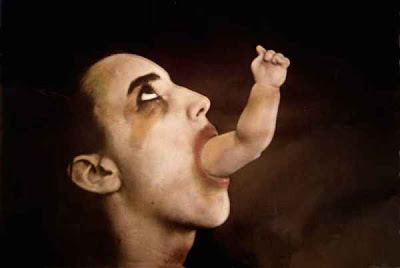Rebecca/Christine: The purpose of our research paper is to look into your filmmaking career as a whole. We have a few questions that we’ve put together after reading about and viewing some of your work. Do you maintain a constant initial process of filmmaking? Which comes first: putting together found footage or writing the script?
Mike: Your question makes me wonder what a constant initial process might look like. Does it mean always beginning? Walking into every room of your life as if you’ve never been there before?
I have lived most of my life near Lake Ontario. Where does the lake start and what could one point to as an ending? I’m sure that science could make the necessary cuts, but I’m interested in different kinds of cover stories. When it comes to starting and finishing lines, I take my cues from the water. My work doesn’t really begin or end any more, most often it is finished right away, nearly instantly, and then undergoes impossible transformations. When I programmed the Images Festival in 2000, I presented the Board with a full slate of shows as soon as I was hired, and then slowly swapped out already chosen titles with incoming wonders. The festival was ready at every moment, and its public expression was only the latest version in a constantly evolving constellation. Sculpture not painting.
Rebecca/Christine: When you watch films, do you keep them in a database of footage for possible use in new work?
Mike: I don’t see so many films these days, I used to be so hungry for them. When I was young I only wanted to inhale. Now I’m more interested in the exhale, letting the pictures touch me, and allowing that touch to run all the way down to the bottom of the exhale, which is where I keep so much of what is difficult and unwanted in experience.
Rebecca/Christine: What are your thoughts on copyright infringement? Is this something you take into consideration when selecting the footage you work with?
Mike: Copyright or copywrong? Copyright imagines movies as a form of property, an extension of the proper name, or another way of saying myself. I think the computer conjures a different form of sharing and subjectivity, it offers a picture of the self as a point on a web. The central picture of today’s computer is the web. Using a computer means being part of this web, stepping into this picture. The web disperses me, casting me off into unknown directions, connecting and relocating me. When I upload a picture from my machine, am I inviting theft or sharing? The computer challenges older ideas of property, which at this moment are defended by large corporations, or by wealthy artistes hoping to maintain traditional revenue streams. These are forms of class warfare, which is founded on an idea of the self as fundamentally separate and autonomous. Copyright infringement shatters that autonomy, it celebrates the impure, the mixmaster cocktails of high and low cultures, and the necessary interrelationship of all experience.
Rebecca/Christine: What is your approach when working with different kinds of media? (i.e. mixing digital footage with film and photographs)
Mike: The picture that theory kingpin Frederic Jameson offered for postmodernism was the flatbed truck. You can load anything onto it, and away it goes. The computer makes this kind of production possible, even inevitable. Mixed formats means that the work has taken time, it has arrived out of a serial encounter, and each of these moments is accompanied with its own media. Why not create a movie with photographs, super 8 reels and high definition video time lapses? You load them into the truck and the mix feels fine, or it doesn’t. These questions of medium specificity, so cherished by modernists, have been shaken loose by this flatbed truck of a computer, which impurely mixes so many formats.
Rebecca/Christine: How do you feel about revisiting your work and modifying it? (As you did with your movies Tom (2002) and House of Pain (1995) and Fascination (2006), to name only three.)
Mike: I used to live in the old analog world, which was made of discrete materials that could be hefted and cut. In the case of cinema this meant plastic strips coated with emulsion and silver halide particles. But today cinema is immaterial, it exists as a series of codes in a computer. Where should these codes begin and where might they end? A work is finished when a button is pushed and an output is made. In the old days finishing meant going to a film lab and “marrying” sound and picture onto a single strip of acetate. Movie makers would see, for the first time, special effects like fades or dissolves in the finished print. Vast amounts of money were spent, and the experience of watching “the end” was a heart pounding exhiliration. But today these operations have been shrunk to the size of a small processing chip, which can perform functions undreamt by even the most sophisticated labs. In place of the delirium of the first time there is a technician’s checking to ensure that the copy is the same as the original. And releasing a movie can mean simply uploading to the internet, where in turn it might be downloaded and reworked. How to say with any definitive sense that a movie is finished or not? Perhaps each movie, as it appears, presents an optimal arrangement of pictures and sounds for that maker, in that moment. But the invitation to view is also, at this digital moment, an invitation to review, to remix, to assert one’s viewing as a digital shape shifting in the form of a remix. In the digital world, seeing doesn’t mean believing, it means taking matters into your own hands.
Rebecca/Christine: What has driven you to use your own voice for the narration in your films? Why is this your preferred approach?
Mike: To thine own self be true. But which one? And which of my so-many voices might you be referring to? When I made a movie about my friend Tom, I did a brief interview with him, and on that particular day he was feeling very vulnerable, and cried often. He was not only remembering but reliving difficult moments from his past — the death of his brother, for example, and of his father. Is this Tom’s true voice? In one memorable after-screening scrum, a friend remarked, “That’s not the Tom I know.” Tom had been a leather wearing S/M top after all, how to square those stern poses with these anguished, hyper-sensitive recollections? (I am hazily remembering my introduction to Tom, which arrived via Scott MacDonald’s extravgant interview with him named, “All the Faces are Us.”)
Of course by holding up Tom’s voice I am dodging the question of my own. How do we come to voice? What does it mean to have a voice, to have a place where one feels safe enough to speak? These are questions I have been struggling with a great deal lately as I have found myself newly paralyzed and voiceless, helplessly caught in old habit patterns where I am unable to find any words at all. Perhaps the words in my movies are a way of speaking to this wordless place, this place of smallness and fear, which is only too familiar.
Rebecca/Christine: What inspires you to write and explore the themes you work with? We’re thinking specifically about memory, time and space, and the philosophies of life.
Mike: You’re asking about inspiration which I think has at least two parts. The first one is: where do ideas come from? And the second, mostly implied, follows on from this to ask: and why do you maintain a practice? Why does it have to go on and on?
I can’t really answer either of these questions of course, though they are helpful to consider. The best questions can’t really be answered. Answers serve to close off a conversation, to close the door, to decide on a matter and be done with it. Questions, on the other hand, are forever opening. Experts have answers while beginners have only questions. And my practice, or at least my aspiration, is to be a beginner.
Rebecca/Christine: What books or films have served as a catalyst and influence to your films?
Mike: There is a Sanskrit word: cit. It is usually translated as consciousness, but it also offers us a picture of the mind as wet clay. We receive sensations at every moment. Some of those leave the lightest of traces and quickly vanish, while others carve deep grooves that we return to again and again. They produce habit energies that we often like to name as me, myself.
What is an influence? What isn’t an influence? I feel so porous, the light on the falling snow yesterday morning was an inspiration. This morning Phyllis, my too kind host here in Ann Arbor, appeared with a bandage wrapped around her head. Yesterday, while waiting to see the celebrated doc maker and Ann Arbor native Ken Burns, she stood up to allow latecomers a seat, and then tripped over her cane in the theatre, and crashed into the armrests across the aisle. She has a wicked line of stitches in her left ear that is livid and angry looking. Her kindly efficient emergency doctor was concerned that she would have cauliflower ear but it seems she has escaped worst case scenarios.
Cinemas large and small are a calling to attention, to the wonders and terrors of this moment. How to stay with our difficult experiences, instead of numbing or distracting ourselves? Our movies provide pictures for how we might live in a molecular way, moment by moment. Why do we gather to sit in the dark? Is it a modelling for how we might sit in the darkness of our own lives, and the lives of our familiar strangers, our unmet and temporary neighbours? Perhaps this is a place where we might hold our silences, the places where we are least able to name, or to bear. We might be sitting not in order to change these old patterns, or at least, not right away. First, the cinema asks us to bear witness, and to become a question. To become a question, to arrive at a place of seeing. We see most powerfully when we can look without deciding, by not jumping into the security of an answer right away, but to to see without knowing before hand what we’re going to see, what is going to happen. To see what is happening regardless of what we want or don’t want. The cinema invites us to see for ourselves, and to see a sitation as clearly as we can. Only after we have borne witness can we decide what to do. Zen sage Bernie Glassman might add that the cinema is the necessary prelude to loving action.





